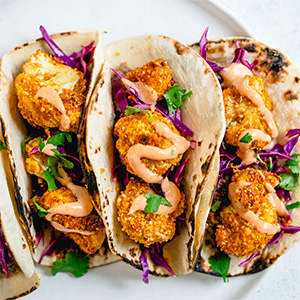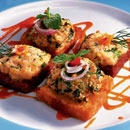4 easy, comforting bean dishes for fall
Published in Variety Menu
Beans are kind of like the your best friend from high school — nearly forgotten but always ready to step back into the limelight and help out an old pal when needed.
As gorgeously (and tantalizingly) demonstrated in Rancho Gordo's new cookbook, "The Bean Book: 100 Recipes for Cooking with All Kinds of Beans" (Ten Speed, $35), beans are indeed a magical fruit, though not in the way you heard as a kid.
Classified as both a vegetable and a plant-based protein in the USDA's Dietary Guidelines for Americans, beans and other legumes can be the ingredient you build an entire vegetarian or veggie-forward meal around. Or, they can help an economical cook stretch a dish twice as far with nutritious calories.
A healthful and shelf-staple plant food — they last for years when dried — beans have been among a home cook's most reliable pantry items for a very long time. (Common beans (Phaseolus vulgaris) are thought to have been grown in Mexico more than 7,000 years ago.)
That's why, for some, they're often something of an afterthought, especially if the only time you ate them as a kid was when your mom tossed kidney beans into a pot of beef chili or made baked beans (with brown sugar and bacon, please!) for a family cookout.
Vegetarians have always appreciated their versatility and nutritional punch, and because they're cheap, they also were quite popular during the Great Depression and World War II as C rations. Sales also peaked during the coronavirus pandemic, when shoppers stockpiled long-lasting pantry essentials.
It wasn't until Rancho Gordo, a California-based bean company, trotted out its branded packages of colorful heirloom beans that the plant began to take on cult status among some shoppers.
Unlike the bean varieties commonly found in even the smallest grocery stores, heirloom beans are mostly forgotten varieties that were developed on a small scale for certain characteristics, with seeds from the best crops passed down through the generations.
The result is beans that are fresher and more colorful than mass-produced beans, and come in different shapes and sizes. They also have a more complex and intense flavor, fans say.
"The Bean Book" dishes up dozens of different ways to cook Rancho Gordo's 50 heirloom bean varieties, which include red-streaked cranberry beans, mint-green flageolets, black and classic garbanzos and (my favorite) vaquero — which wear the same black-and-white spots as a Holstein cow.
Other gotta-try varieties (if just for the name) include eye of the goat, European Soldier, Jacob's Cattle and Good Mother Stallard, a purple bean with cream-colored flecks.
"The very good news is that you have to work extra hard to mess up a pot of beans, and it's not difficult to make an excellent pot," Steve Sando writes in the book's foreword. "The even better news is that you become a better cook with each pot you make."
Not convinced? Here are five reasons to jump on the bean bandwagon:
They're easy to find
Even the smallest grocery store will have a selection of dried and canned beans. Common varieties include black, cannellini (white kidney), Great Northern, pinto, navy, kidney, Lima and garbanzo (chickpea) beans.
They're affordable
Even when they're not on sale, beans are a bargain at the supermarket. Many varieties cost less than $1 a can, and dried beans are an economical way to build a menu. I paid $1.25 for a one-pound bag of cranberry beans, a smooth and velvety bean with a slightly nutty flavor, at my local grocery store.
Rancho Gordo's heirloom beans cost substantially more. (They run $6.25-$7.50 for a one-pound bag, with free shipping on orders over $50.) But they are sold within a year of harvest, which makes them more flavorful and tender. A bag also comes with cooking instructions and recipe suggestions, and the quality is outstanding.
Plus, after cooking their beans with aromatics, "you are left with essentially free soup," Sando writes in the cookbook. "If you drain properly cooked and seasoned beans, the liquid you are left with is delicious."
They're nutritious
Beans are a great source of plant-based protein and both soluble and insoluble fiber, and they include essential minerals like iron, magnesium and potassium. If you're watching your weight or following a particular diet, beans are naturally free of fat, sodium and cholesterol and are rich in complex carbohydrates. They also contain antioxidants and folate. And if you're vegan or vegetarian, most types of dry beans are rich sources of iron.
The U.S. Dietary Guidelines for Americans recommends eating 1-3 cups of legumes, including beans, per week
They're a cinch to cook
Dry beans have to be soaked overnight, but cooking them is easy. They can be cooked on the stovetop, in a slow cooker, in the pressure cooker and in the oven. Canned beans are even easier — just rinse and drain, and they're ready to go.
They're versatile
Beans can be used in so many different dishes. They can be made into soup, salad or dips, top nachos, add some heft to a casserole or be mashed into the makings of a veggie burger. You also can add them to brownies and other baked goods, toss them with pasta, add them to chili or a rice bowl or stuff them into a taco or burrito.
Check out these four recipes:
White Bean Soup with Shiitake Bacon
PG tested
This light and creamy vegetarian soup benefits from a surprising garnish, roasted shiitake mushrooms, which taste exactly like bacon.
For soup
1/4 cup olive oil
1 medium yellow onion, chopped
2 celery stalks, chopped
1 medium carrot, scrubbed and chopped
6 garlic cloves, finely grated or pressed
2 sprigs fresh thyme, plus more for garnish
1/2 teaspoon sea salt
1/4 teaspoon pepper
4 cups vegetable broth
2 15-ounce cans cannellini beans, drained and rinsed
For bacon
8 ounces shiitake mushrooms, caps cut into 1/8 -inch slices
2 tablespoons olive oil
1/4 teaspoons fine sea salt
To finish
Plant-based milk
Chili oil, for drizzling
Preheat oven to 400 degrees.
Make soup: In large pot, heat oil over medium heat until it shimmers. Add onion, celery, carrot, garlic, thyme, salt and pepper.
Cook, stirring occasionally, until vegetables are fragrant and tender, 8-10 minutes.
Add vegetable stock and beans, increase heat to high and bring mixture to a boil. Reduce heat to medium and simmer until thickened, 12-14 minutes.
Meanwhile, make the bacon: Spread shiitake mushrooms into a single layer on a sheet pan, drizzle with olive oil, sprinkle with salt and pepper and toss to combine. Bake until browned and crispy, 18-20 minutes, rotating pan front to back and tossing mushrooms with a spatula halfway through. Let cool in pan; mushrooms will continue to crisp as they cool.
To finish, add some milk to the soup and use an immersion blender to puree it in the pot, or puree in a blender. (Cover lid with a clean kitchen towel.) Taste and season with more salt and pepper if needed.
Divide soup among bowls and top with shiitake bacon. Garnish with thyme sprigs and a drizzle of chili oil.
Serves 4-6.
— "Mastering the Art of Plant-Based Cooking" by Joe Yonan
Polenta with Cranberry Beans and Tomato Sauce
PG tested
Velvety cranberry beans simmered with tomato and the punch of red wine vinegar are a perfect match for a soft bed of cheesy polenta. This is a filling, stick-to-your-ribs dish perfect for fall.
1/4 cup olive oil
1 small onion, finely chopped
2 garlic cloves, minced
2 cups canned chopped tomatoes, juice reserved
1 tablespoon red wine vinegar
2 tablespoons tomato paste
1 cup chicken or vegetable broth
4 fresh sage leaves
Salt and pepper
4 cups cooked Lamon or cranberry beans
2 cups uncooked polenta
6 ounces pancetta, diced
Chopped fresh basil or parsley, for garnish
Grated Parmesan cheese, for serving
In large pan, heat olive oil over medium heat. Add onion and garlic and cook, stirring, until onion begins to soften, about 3 minutes.
Stir in tomatoes and red wine vinegar.
In a small bowl, dissolve tomato paste in the broth and add to pan. Stir in sage and season with salt and pepper. Simmer, stirring occasionally, until the sauce has thickened, 15-20 minutes.
Add beans to tomato sauce. Cook, stirring frequently, until heated through, about 15 minutes.
Meanwhile, prepare polenta according to package instructions.
Place pancetta in a small saucepan over low heat.
Cook, stirring frequently, until the pancetta is brown and crisp, about 15 minutes. Use a slotted spoon to transfer pancetta to a paper towel to drain.
To serve, spoon polenta into serving dishes. Ladle the beans over the polenta and top with the pancetta. Garnish with fresh basil and serve with grated Parmesan.
Serves 6.
— "The Bean Book: 100 Recipes for Cooking with All Kinds of Beans" by Steve Sando
White Beans with Clams and Chorizo
PG tested
Beans and seafood might seen like an unusual pairing, but in this recipe, mild white beans take on a lot of flavor from clams. Spanish chorizo adds a nice contrast.
4 cups cooked white beans, bean broth reserved
1/4 cup extra-virgin olive oil
1/2 white onion, chopped
2 garlic cloves, chopped
1 teaspoon salt, or to taste
1/2 cup finely chopped Spanish-style cured chorizo
2 plum tomatoes, chopped
1/2 cup dry white wine
2 pounds small clams, scrubbed well
Chopped fresh parsley, for garnish
Country-style bread and butter, for serving
In large pot, heat beans in their broth over medium-low heat.
In large lidded saucepan, warm olive oil over medium-low heat. Add onion, garlic and salt and cook until soft, about 5 minutes.
Add chorizo and cook gently until some of the fat has rendered, about 5 minutes.
Add tomatoes and wine and cook to allow the flavors to mingle, 5-6 minutes.
Increase heat to medium and add clams. Cover and cook for about 5 minutes, shaking the pan occasionally.
Uncover the pan and cook until all of the clams open, another few minutes. Remove pan from heat, then remove and discard any clams that failed to open.
Add clam mixture to the bean pot and stir very gently until well mixed. Simmer for a few minutes to allow the flavors to mingle but not get mushy.
Ladle into large, shallow bowls and sprinkle with parsley. Set out a large bowl for discarded shells and encourage guests to eat with their fingers.
Pass plenty of good bread and creamy butter at the table
Serves 4-6.
— "The Bean Book: 100 Recipes for Cooking with All Kinds of Beans, from the Rancho Gordo Kitchen" by Steve Sando with Julia Newberry
White Bean Dip
PG tested
So easy to pull together for your next party!
1 1/2 cups cooked cannellini beans, drained and rinsed
2 tablespoons extra-virgin olive oil
Juice and zest of 1 lemon
1 small garlic clove, minced
Generous pinch of salt
Freshly ground black pepper
2 or 3 tablespoons water, if needed
2 fresh basil leaves, chopped, optional
1 sprig fresh rosemary, leaves chopped, optional
In a food processor, pulse cannellini beans, olive oil, lemon juice and zest, garlic, salt and several grinds of pepper until combined.
If it's too thick, slowly add the water with the food processor running until it is smooth and creamy. Blend in the basil and/or rosemary, if using
Serve with veggies, pita or bruschetta.
Makes 1 1/2 cups
— Gretchen McKay, Post-Gazette
©2024 PG Publishing Co. Visit at post-gazette.com. Distributed by Tribune Content Agency, LLC.















Comments